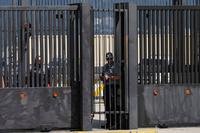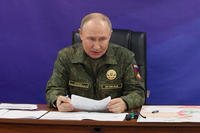As large-scale training resumes under COVID-19 conditions, Army combat leaders are finding that coronavirus infections affect units the same way as battlefield casualties.
"It certainly impacts a unit when you lose a couple of key folks for 14 days; it also reinforces the importance of that one-up drill where next [soldier] in succession is absolutely ready to take charge of whatever element that it is that the leader may be out of for a period of time," Maj. Gen. Brian Winski, commander of the Army's 101st Airborne Division (Air Assault), told Military.com.
The Fort Campbell, Kentucky-based unit just completed back-to-back brigade combat team rotations at the Joint Readiness Training Center (JRTC) at Fort Polk, Louisiana -- a dramatic shift from six months ago, when combat units essentially paused training to prevent the spread of the deadly pandemic.
Read Next: Marine Corps Assistant Commandant Is 2nd Top Military Leader to Contract COVID-19
Safety protocols such as masks and social distancing have been effective, but the virus continues to be a real threat that is now impacting the U.S. military's senior leadership. Shortly after President Donald Trump tested positive for the virus last week, the Coast Guard's vice commandant, Adm. Charles Ray, and Assistant Commandant of the Marine Corps Gen. Gary Thomas tested positive this week.
Following Ray's diagnosis, Thomas and eight other senior military leaders went into quarantine.
"It's out there; it hasn't gone away yet," Col. Mike Kovacevic, commander of the 101st's 2nd Brigade Combat Team, told Military.com. "COVID-19 is here. It's a fact of life. It's a fact of training ... and you do have to remain on guard."
Kovacevic's brigade slowly started to return to training in May, starting with individual and small-unit training while following strict COVID-19 safety guidelines.
"We kind of stopped, looked and said, 'Hey, we have to continue to train,'" Kovacevic said, adding that by June leaders began "understanding where we needed to be ... to go to JRTC."
Units gradually began conducting larger-scale, company- and battalion-level training to prepare for the intense efforts against the JRTC's sophisticated opposing force, which is equipped with armored vehicles, attack helicopters and electronic warfare jamming capabilities.
"Through all of that, we found that you can train by being safe and adhering to the best practices," Kovacevic said. "If somebody tested positive for COVID-19 ... everybody at different levels has to be prepared to step up."
Kovacevic's 2nd BCT went to JRTC in late July and part of August, followed by the 1st BCT in September.
"We 100% tested everybody that participated in the rotations; those that we found that were positive ... we kept them in isolation here," Winski said.
While positive cases were few -- less than 2% from each BCT -- it meant the removal of key figures. For example, a platoon leader, company commander or senior noncommissioned officer might have to be removed from units with no notice, Winski said.
"It's fundamentally the same thing you do for taking combat casualties; everybody has got to be ready to assume the next level up," he added. "This was a no-kidding, this guy is coming out right now. You are not going to have time for a little handoff discussion because we had to minimize exposure once we knew ... their test came back positive."
Overall, the Army has been responsible for 17,803 of the Pentagon's 47,658 uniformed cases of COVID-19; there have been eight deaths across the services, according to Defense Department numbers.
"As we turn collective training back on, our numbers have grown," Army Secretary Ryan McCarthy said Wednesday during a virtual event at the Hudson Institute. "People get sick, and we are just trying to muscle through it because there are objectives we have to reach."
Once each brigade had been tested at Campbell, units were restricted to a safety bubble before moving to JRTC to "get them down there and into the training area with minimal opportunities for vectors to come in ... that you normally have here on the installation out in restaurants and in the community," Winski said.
"It illuminated for us the conditions that we have to operate in, and I think that is going to be the case for the foreseeable future."
-- Matthew Cox can be reached at matthew.cox@military.com.
Related: Military Leaders in Quarantine After Coast Guard's No. 2 Admiral Tests Positive for COVID-19













